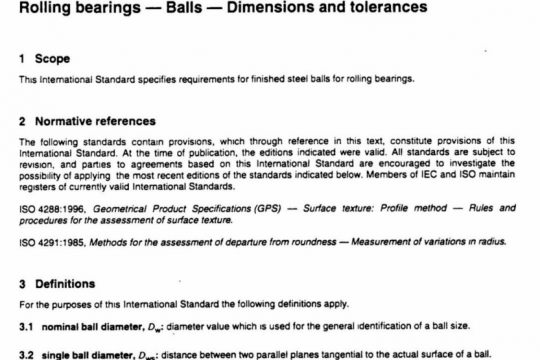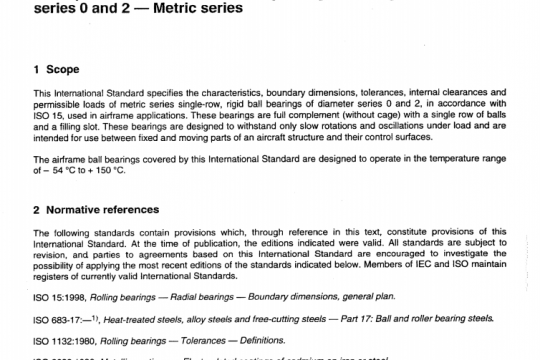ABMA ISO 10A:2001 pdf free
ABMA ISO 10A:2001 pdf free.Metal Balls for Unground Bearings and Other Uses
Measurement methods – size and size variation. For ball grades G3A G200A, comparative methods shall be used. For ball grades greater than G200A, micrometers of known calibration status capable of measuring to 0.001 mm (or 0.0001 inch) may be used for determining size and variation of ball lot.
Masters for comparative measurements. Masters used for comparative measurements of size and variation of ball lot shall be made with masters traceable to the National Institute of Standards and Technology (NIST). The size of the master balls, or blocks shall be corrected to zero gage pressure, and to a temperature of 20°C (68*F).
Master materials. Master balls or blocks may be made of hardened chrome steel, tungsten carbide, or composite materials such as alumina oxide or zirconia. Hardness shall be 64 HRC or higher. When master balls are used for ball sizes of 1.5 mm (1/16 inch) diameter and smaller, master balls may be 440 stainless steel, 60 HRC or higher.
Master balls. The permissible diameter variation shall be one-tenth of the allowable diameter variation for the ball grade being measured, or 0.05 micrometers (2 micro-inches), whichever is larger. The calibrated diameter of the master ball is defined as the mean of at least twenty (20) randomly oriented diameters and must be known to an accuracy equal to plus or minus the magnitude of the permissible diameter variation of the master ball or plus or minus 0.08 micrometers (3 micro-inches), whichever is larger.
Master gage blocks. Master blocks used for comparative measurements shall have a known calibration status. Gage block sets shall be Grade 2, or better, as defined by Federal Specification GGG-G- 15C, except as noted below. When more than one block is used for comparative measurement, proper compensation, as defined in the calibration record of the set, shall be taken for each block used in the setup.Exception: Lower grade sets, or blocks, may be used provided the gage block deviation from nominal size is known, and proper compensation for deviation is taken during the setup, or interpretation of the measured size.
Gage pressures. Gage contact materials shall have at least the same hardness as the ball measured. Gage contacts must be flat, or if convex, have a contact radius not less than 3 mm or 0.125 inch. Maximum measuring pressures at gage contacts shall not exceed 1.1 newtons (4 ounces) for balls up to and including 25 mm (1 inch) nominal diameter and not exceed 2.2 newtons (8 ounces) for larger nominal diameters, including ball weight if significant.ABMA ISO 10A pdf free download.




